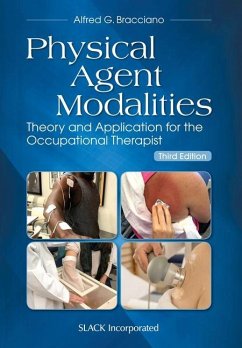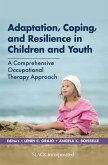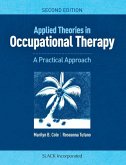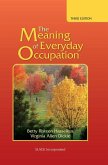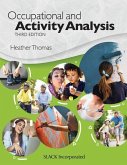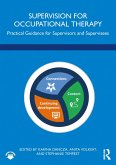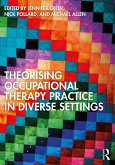- Broschiertes Buch
- Merkliste
- Auf die Merkliste
- Bewerten Bewerten
- Teilen
- Produkt teilen
- Produkterinnerung
- Produkterinnerung
The popular occupational therapy textbook Physical Agent Modalities: Theory and Application for the Occupational Therapist has been newly updated and revised into a comprehensive Third Edition which establishes the theoretical basis and clinical reasoning for the use of physical agent modalities in practice.
Andere Kunden interessierten sich auch für
![Adaptation, Coping, and Resilience in Children and Youth Adaptation, Coping, and Resilience in Children and Youth]() Lenin GrajoAdaptation, Coping, and Resilience in Children and Youth112,99 €
Lenin GrajoAdaptation, Coping, and Resilience in Children and Youth112,99 €![Bringing Evidence Into Everyday Practice Bringing Evidence Into Everyday Practice]() Winnie DunnBringing Evidence Into Everyday Practice64,99 €
Winnie DunnBringing Evidence Into Everyday Practice64,99 €![Applied Theories in Occupational Therapy Applied Theories in Occupational Therapy]() Marilyn B. ColeApplied Theories in Occupational Therapy125,99 €
Marilyn B. ColeApplied Theories in Occupational Therapy125,99 €![The Meaning of Everyday Occupation The Meaning of Everyday Occupation]() Betty Risteen HasselkusThe Meaning of Everyday Occupation86,99 €
Betty Risteen HasselkusThe Meaning of Everyday Occupation86,99 €![Occupational and Activity Analysis Occupational and Activity Analysis]() Heather ThomasOccupational and Activity Analysis123,99 €
Heather ThomasOccupational and Activity Analysis123,99 €![Supervision for Occupational Therapy Supervision for Occupational Therapy]() Supervision for Occupational Therapy53,99 €
Supervision for Occupational Therapy53,99 €![Theorising Occupational Therapy Practice in Diverse Settings Theorising Occupational Therapy Practice in Diverse Settings]() Theorising Occupational Therapy Practice in Diverse Settings37,99 €
Theorising Occupational Therapy Practice in Diverse Settings37,99 €-
-
-
The popular occupational therapy textbook Physical Agent Modalities: Theory and Application for the Occupational Therapist has been newly updated and revised into a comprehensive Third Edition which establishes the theoretical basis and clinical reasoning for the use of physical agent modalities in practice.
Hinweis: Dieser Artikel kann nur an eine deutsche Lieferadresse ausgeliefert werden.
Hinweis: Dieser Artikel kann nur an eine deutsche Lieferadresse ausgeliefert werden.
Produktdetails
- Produktdetails
- Verlag: SLACK Incorporated
- 3 ed
- Seitenzahl: 474
- Erscheinungstermin: 1. Juni 2022
- Englisch
- Abmessung: 254mm x 178mm x 25mm
- Gewicht: 896g
- ISBN-13: 9781630915384
- ISBN-10: 1630915386
- Artikelnr.: 64088415
- Herstellerkennzeichnung
- Libri GmbH
- Europaallee 1
- 36244 Bad Hersfeld
- gpsr@libri.de
- Verlag: SLACK Incorporated
- 3 ed
- Seitenzahl: 474
- Erscheinungstermin: 1. Juni 2022
- Englisch
- Abmessung: 254mm x 178mm x 25mm
- Gewicht: 896g
- ISBN-13: 9781630915384
- ISBN-10: 1630915386
- Artikelnr.: 64088415
- Herstellerkennzeichnung
- Libri GmbH
- Europaallee 1
- 36244 Bad Hersfeld
- gpsr@libri.de
Alfred G. Bracciano, MScA, EdD, OTR/L, FAOTA, is a clinician and academician. He earned his undergraduate degree in Occupational Therapy from Wayne State University (Detroit, Michigan); his Master of Science degree in Hospital and Health Administration at Central Michigan University (Mt. Pleasant, Michigan); and his doctorate in Educational Leadership from Western Michigan University (Kalamazoo, Michigan). He was inducted as a Fellow in the American Occupational Therapy Association (AOTA) for his work in expanding international practice and professional education. Dr. Bracciano holds an academic appointment as Professor at Creighton University, Coordinator of the Creighton University/University of Alaska Pathway; Visiting Professor, Jinan University, Guangzhou, China; and Lecturer, Yonsei University, Seoul, South Korea. Prior to his appointment at Creighton, Dr. Bracciano held appointments as Founding Chair and Professor, Occupational Therapy Program, Saginaw Valley State University in Michigan; as well as Clinical Associate Professor, Stony Brook University in New York. Dr. Bracciano has been a vocal advocate in the appropriate use and application of physical agent modalities and assisted several states and organizations in developing licensing and regulatory guidelines related to their use. He has published and lectured extensively on physical agents, their clinical application, education, and competency in occupational therapy with more than 200 national and international presentations. He is recognized as a subject matter expert on physical agents to the AOTA and the U.S. Department of Defense, U.S. Army. Dr. Bracciano has served on a variety of AOTA committees related to licensing and regulations, scope of practice, and physical agents; coauthored the AOTA Position Statement on Physical Agent Modalities; and contributed chapters to several rehabilitation textbooks, including Radomski and Trombly's Occupational Therapy for Physical Dysfunction, Fifth and Sixth Editions; Jacobs and MacRae's Occupational Therapy Essentials for Clinical Competence, Third Edition; and Mahle and Ward's Adult Physical Conditions: Intervention Strategies for Occupational Therapy Assistants. Dr. Bracciano serves as a reviewer and on editorial boards for the American Journal of Occupational Therapy, British Journal of Occupational Therapy, Journal of Rural Health, Journal of Alternative Complementary & Integrative Medicine, Chinese Journal of Clinical Rehabilitative Tissue Engineering Research, and Journal of Athletic Medicine.
Dedication Acknowledgments About the Author Contributing Author Preface
Chapter 1 Physical Agent Modalities: A Theoretical Framework Chapter 2
Regulatory Guidelines for the Use of Physical Agents Addendum: Summary of
States Requiring Competency in Physical Agents Chapter 3 Wound Healing
Chapter 4 Pain Theory and Perception Chapter 5 Cryotherapy Chapter 6
Thermal Modalities: Therapeutic Heat Chapter 7 Therapeutic Ultrasound and
Phonophoresis Chapter 8 Principles of Electrotherapy Chapter 9
Neuromuscular Electrical Stimulation: Applications and Indications Chapter
10 Transcutaneous Electrical Nerve Stimulation Chapter 11 Iontophoresis
Chapter 12 Low-Level Laser Therapy, Light Therapy, and Diathermy Appendix A
Neuromuscular Electrical Stimulation Hand Rehabilitation Guide Appendix B
Neuromuscular Electrical Stimulation Parameter Overview Appendix C
Microcurrent Electrical Therapy and Cranial Electrotherapy Stimulation
Treatment Protocols Appendix D Considerations, Conditions, Precautions, and
Contraindications Index
Chapter 1 Physical Agent Modalities: A Theoretical Framework Chapter 2
Regulatory Guidelines for the Use of Physical Agents Addendum: Summary of
States Requiring Competency in Physical Agents Chapter 3 Wound Healing
Chapter 4 Pain Theory and Perception Chapter 5 Cryotherapy Chapter 6
Thermal Modalities: Therapeutic Heat Chapter 7 Therapeutic Ultrasound and
Phonophoresis Chapter 8 Principles of Electrotherapy Chapter 9
Neuromuscular Electrical Stimulation: Applications and Indications Chapter
10 Transcutaneous Electrical Nerve Stimulation Chapter 11 Iontophoresis
Chapter 12 Low-Level Laser Therapy, Light Therapy, and Diathermy Appendix A
Neuromuscular Electrical Stimulation Hand Rehabilitation Guide Appendix B
Neuromuscular Electrical Stimulation Parameter Overview Appendix C
Microcurrent Electrical Therapy and Cranial Electrotherapy Stimulation
Treatment Protocols Appendix D Considerations, Conditions, Precautions, and
Contraindications Index
Dedication Acknowledgments About the Author Contributing Author Preface
Chapter 1 Physical Agent Modalities: A Theoretical Framework Chapter 2
Regulatory Guidelines for the Use of Physical Agents Addendum: Summary of
States Requiring Competency in Physical Agents Chapter 3 Wound Healing
Chapter 4 Pain Theory and Perception Chapter 5 Cryotherapy Chapter 6
Thermal Modalities: Therapeutic Heat Chapter 7 Therapeutic Ultrasound and
Phonophoresis Chapter 8 Principles of Electrotherapy Chapter 9
Neuromuscular Electrical Stimulation: Applications and Indications Chapter
10 Transcutaneous Electrical Nerve Stimulation Chapter 11 Iontophoresis
Chapter 12 Low-Level Laser Therapy, Light Therapy, and Diathermy Appendix A
Neuromuscular Electrical Stimulation Hand Rehabilitation Guide Appendix B
Neuromuscular Electrical Stimulation Parameter Overview Appendix C
Microcurrent Electrical Therapy and Cranial Electrotherapy Stimulation
Treatment Protocols Appendix D Considerations, Conditions, Precautions, and
Contraindications Index
Chapter 1 Physical Agent Modalities: A Theoretical Framework Chapter 2
Regulatory Guidelines for the Use of Physical Agents Addendum: Summary of
States Requiring Competency in Physical Agents Chapter 3 Wound Healing
Chapter 4 Pain Theory and Perception Chapter 5 Cryotherapy Chapter 6
Thermal Modalities: Therapeutic Heat Chapter 7 Therapeutic Ultrasound and
Phonophoresis Chapter 8 Principles of Electrotherapy Chapter 9
Neuromuscular Electrical Stimulation: Applications and Indications Chapter
10 Transcutaneous Electrical Nerve Stimulation Chapter 11 Iontophoresis
Chapter 12 Low-Level Laser Therapy, Light Therapy, and Diathermy Appendix A
Neuromuscular Electrical Stimulation Hand Rehabilitation Guide Appendix B
Neuromuscular Electrical Stimulation Parameter Overview Appendix C
Microcurrent Electrical Therapy and Cranial Electrotherapy Stimulation
Treatment Protocols Appendix D Considerations, Conditions, Precautions, and
Contraindications Index

